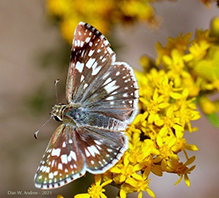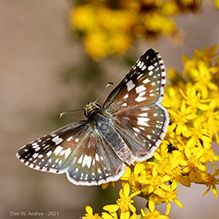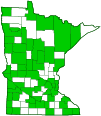Common checkered-skipper
(Burnsius communis)
Conservation • Description • Habitat • Ecology • Distribution • Taxonomy
Conservation Status |
|||
| IUCN Red List | not listed |
||
| NatureServe | N5 - Secure SNA - Not applicable |
||
| Minnesota | not listed |
||
Description
Common checkered-skipper is a large spread-wing skipper. It occurs throughout the contiguous United States, in western Canada, Mexico, Central America, and South America. It has been called “the most common and widespread skipper in North America.” It is common in Minnesota, most common in late summer and fall.
Adults are active from early June to late September. They are found in dry open places, including prairies, old fields, pastures, parks, urban gardens, vacant lots, railroads, roadsides, and other disturbed areas. The feed on flower nectar, mostly but not exclusively on white flowers. Larvae feed on the leaves of plants in the mallow family, including common mallow, round-leaved mallow, and velvet-leaf.
The antennae are banded dark brown and white, and are distinctly hooked at the end.
The forewing is ½″ to ⅝″ (13 to 15 mm) long, and the wingspan is 1″ to 1½″ (25 to 38 mm). The wings are held spread wide when at rest. This is the feature that gives the subfamily Pyrginae its common name. The upperside of the wing is grayish-brown, blackish-brown, or reddish-brown. The thorax and the upperside of each wing near the base is covered with long hairs. The hairs are brown or black with some white on the female, bluish-gray with some white on the male. This causes the male to appear bluish in flight. The male also has a fold near the leading edge (costal margin) of the forewing that encloses specialized scent cells. There is a median band of large white spots, a submarginal band of smaller white spots, and a marginal band of very small white spots. This checkered pattern is the feature that gives the genus its common name. The marginal band is incomplete, missing the spot at the leading outer corner (apex). The central area of the forewing (cell) has a large spot near the end and a very small spot or no spot at all at the end. The fringe is checkered dark brown and white. On the male, some but not all of the checks in the fringe may be black. The underside of both wings mirrors the upperside, but is much paler and has larger white spots, making it appear mostly white with light brown stripes and spots. On the leading margin of the hind wing near the base there is a black “telephone”-shaped mark.
The caterpillar is up to 1″ long and waxy green to pinkish. It is covered with numerous minute white spots and short white hairs (setae). There is a grayish-green stripe in the middle (dorsal) and a cream-colored stripe on each side (subdorsal). The head and the collar on the first segment of the thorax (prothorax) are both dark brown. The collar has long white setae.
Size
Wingspan: 1″ to 1½″ (25 to 38 mm)
Similar Species
Northern Grizzled Skipper (Pyrgus centaureae freija) has smaller white spots with gaps between the spots.
The caterpillar description above could be used with little or no change for a number of skipper species. The common checkered-skipper caterpillar is distinguished by somewhat longer hairs on the body and long hairs on the prothoracic collar. It is also the only skipper caterpillar in Minnesota to be found on mallow.
Habitat
Dry open places, including prairies, old fields, pastures, parks, urban gardens, vacant lots, railroads, roadsides, and other disturbed areas.
Ecology
Season
Two overlapping generations per year: Early June to late September
Behavior
Adults are strong fliers. They hold their wings spread wide when at rest. They perch well off the ground on a tall plant.
The caterpillar creates a shelter to feed in by cutting two channels, folding over the resulting flap, and securing it with silk.
Life Cycle
The female lays single large eggs on the tops of leaves or on leaf buds. Mature caterpillars overwinter. Caterpillars may not survive Minnesota’s cold winters. Adults migrate north in the spring.
Larva Food/Hosts
Plants in the mallow family (Malvaceae), including mallows, poppy mallows, and velvet-leaf.
Adult Food
Flower nectar, mostly but not exclusively on white flowers
Distribution |
||
|
Sources Biodiversity occurrence data published by: Minnesota Biodiversity Atlas (accessed through the Minnesota Biodiversity Atlas Portal, bellatlas.umn.edu, 11/29/2025). |
|
| 11/29/2025 | ||
Occurrence |
||
Common and widespread |
||
Taxonomy
Order
Lepidoptera (Butterflies and Moths)
Superfamily
Papilionoidea (Butterflies)
Family
Hesperiidae (Skippers)
Subfamily
Pyrginae (Spread-wing Skippers)
Tribe
Pyrgini (Checkered-skippers, White-skippers, and Allies)
Genus
Burnsius (New World checkered-skippers)
Superfamily
Skippers have traditionally been placed in their own superfamily Hesperioidea because of their morphological similarity. Recent phylogenetic analysis (Kawahara and Breinholt [2014]) suggests that they share the same common ancestor as other butterfly families, and thus belong in the superfamily Papilionoidea.
Genus
This species was formerly classified as Pyrgus communis. A recent analysis of the DNA of 250 skippers (Li, Wenlin; Cong, Qian; Shen, Jinhui; Zhang, Jing; et al. [2019]) resulted in a reconstruction of the tree of the skipper family Hesperiidae. Nine new genera were defined. New World checkered-skippers were placed in the new genus Burnsius.
Subordinate Taxa
Mexican checkered-skipper (Burnsius communis albescens)
northern checkered-skipper (Burnsius communis communis) ![]()
Synonyms
Pyrgus communis
Common Names
common checkered-skipper
Glossary
Cell
In Lepidoptera: the large central area of the wing surrounded by veins.
Costal margin
The leading edge of the forewing of insects.
Seta
A stiff, hair-like process on the outer surface of an organism. In Lepidoptera: A usually rigid bristle- or hair-like outgrowth used to sense touch. In mosses: The stalk supporting a spore-bearing capsule and supplying it with nutrients. Plural: setae. Adjective: setose.
A Note on the Color
Technical descriptions, both in printed field guides and on the Web, give the color of the wing upperside as bluish-gray or black for the male and black or dark brown for the female. Yet the photos in these same field guides, and all photos of adults on BugGuide.net, clearly show the wing upperside to be always some shade of brown – bluish-brown, grayish-brown, blackish-brown, or reddish-brown.
Visitor Photos
Share your photo of this insect.
This button not working for you?
Simply email us at info@MinnesotaSeasons.com.
Attach one or more photos and, if you like, a caption.
Dan W. Andree |
||
Checkered Skipper... This small butterfly was feeding on prairie flowers Sept. 5-6th 2021 Frenchman’s Bluff SNA Norman Co. Mn. |
||
 |
 |
|
MinnesotaSeasons.com Photos
|
|

Slideshows

Visitor Videos
Share your video of this insect.
This button not working for you?
Simply email us at info@MinnesotaSeasons.com.
Attach a video, a YouTube link, or a cloud storage link.
Other Videos
Common Checkered Skipper female (Pyrgus communis) on Longleaf Aster
Nature in Motion
Common Checkered-Skipper (Pyrgus communis) Working
Nature's Wild Things
Common Checkered-Skipper (Pyrgus communis)
Rudyard Wallen

Visitor Sightings
Report a sighting of this insect.
This button not working for you?
Simply email us at info@MinnesotaSeasons.com.
Be sure to include a location.
Minnesota Seasons Sightings


